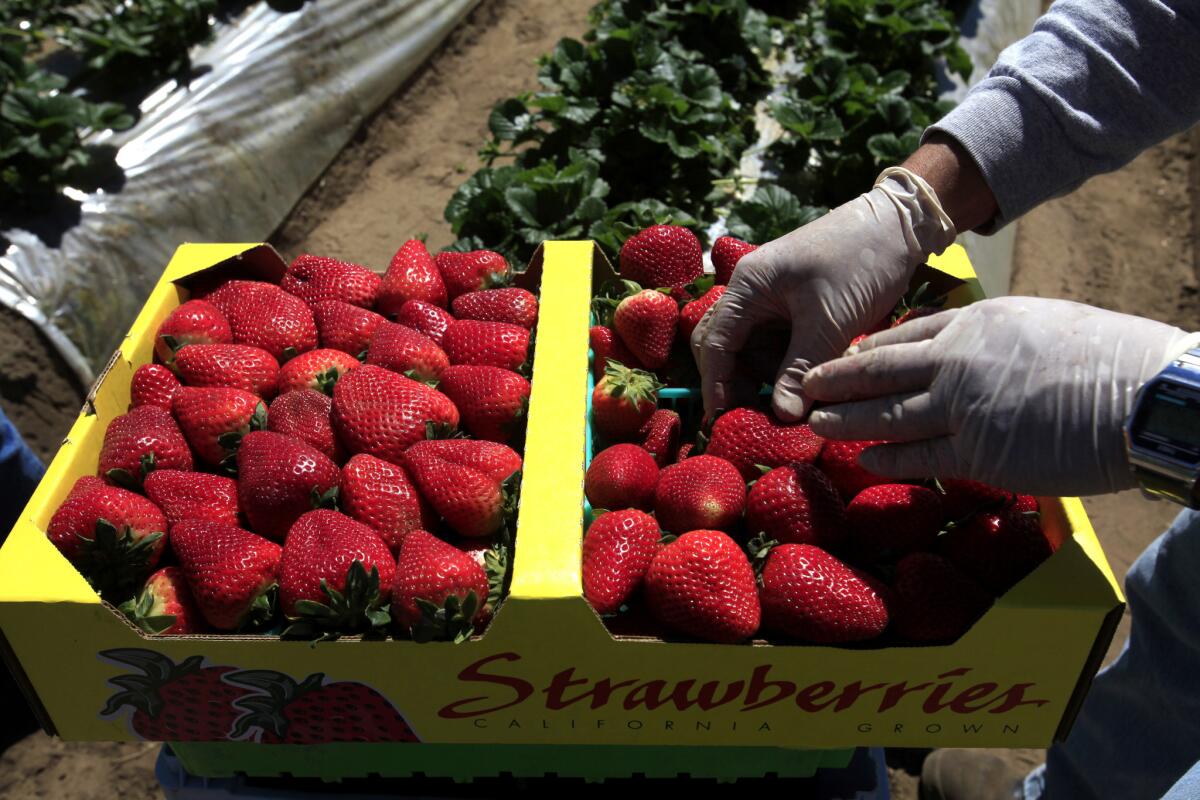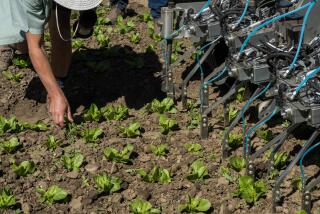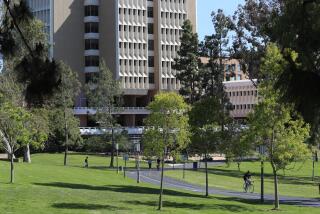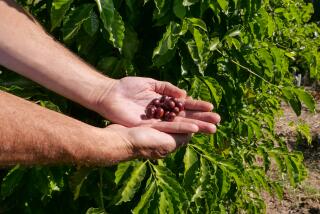Great Read: Strawberry expert at center of battle over fruit’s future

Reporting from Watsonville, Calif. — On an ocean-facing hillside with stunning views of Monterey Bay, Douglas Shaw circulates among thousands of strawberry plants he has helped to breed and grow. But the man who is considered California’s most esteemed strawberry expert declines to choose his all-time favorite.
The UC Davis plant sciences professor is a bit like a father unwilling to favor one child above his others — patented strawberry varieties with names such as Albion, Benicia, Portola, Monterey and San Andreas. He’s also an unsentimental scientist with an eye toward hardier and tastier descendants.
“You can’t get too attached to them, because the idea is that you are supposed to be replacing them with something better,” he said.
He bites into one berry and reports that it tastes both sweet and acidic, a combination some people crave.
“It’s not rocket science,” he said of his evaluations. “It’s objectivity.”
Watsonville’s fog, sandy soil and cool temperatures, often just in the 60s during summer days, make it ideal for growing the berries. Farmers here produce the most strawberries in the state, far surpassing growers in other productive areas in Santa Maria, Oxnard and Irvine.
Across town, the quasi-governmental California Strawberry Commission has its headquarters in an office suite decorated with photos of strawberry baskets and harvests and a floor rug in the shape of a berry. At the office entrance, as if emphasizing the connection to the world of fields and supermarkets, a white board lists temperatures throughout the state, prices and production statistics.
Watsonville has long been ground zero for California’s $2.3-billion-a-year strawberry industry. Now it has taken center stage in a sour legal battle over the fruit’s — and Shaw’s — future.
::
The stakes are substantial as the dispute unfolds beyond the fields of leafy plants that sprout delicate white blossoms and red fruit.
For universities, it spotlights their role in the nation’s agribusiness and the rights to intellectual property that, in this case, just happens to be edible. And for California farmers, it could mean the end of easy access to the sweetest strawberries that best survive the journeys from field to warehouse to kitchen tables.
The whole thing was set into motion when the 60-year-old Shaw, after nearly three decades at the university, said he and his research partner, UC breeding expert Kirk Larson, planned to leave UC and start a private company for strawberry crop development.
Asserting that UC was no longer interested in their work, he also said they wanted to take a share of a valuable UC inventory of strawberry specimens dating back to the 1930s.
The Strawberry Commission, which represents mainly growers and packers, was alarmed. It sued the University of California, alleging the university was endorsing the privatization of an important part of the state’s agricultural heritage. UC denies the allegations.
For many years, the commission helped fund the UC research to the tune of $350,000 annually. In a related deal, strawberry nurseries throughout the state got discounts on the royalties they paid to grow and sell the UC varieties. The lawsuit alleges that the end of both arrangements two years ago was a breach of contract.
The suit also claims the university is not properly safeguarding the so-called germplasm, a living museum of 1,600 strawberry types sustained over decades of careful reproduction, plantings and refrigeration at UC’s farm properties in Davis, Watsonville and Irvine.
UC is ceding control to Shaw and Larson “in a classic case of the fox guarding the henhouse,” the lawsuit says.
The university insists that it will continue a public-oriented strawberry breeding program after Shaw and Larson leave and replacements are hired. Accusing the commission of spreading alarmist and false information, the university says its staff has cultivated and will protect extra copies of all strawberry specimens in the inventory.
“This breeding program is really important to the university, this state and worldwide,” said Jacob Appelsmith, UC Davis’ chief counsel. “For whatever reasons, there has been some anxiety given that these breeders are retiring. But we are doing everything we can to expand and improve it.”
UC recently asked an Alameda County Superior Court judge to dismiss the lawsuit, saying the commission had no right to dictate any aspect of UC strawberry research.
::
California produces 90% of the nation’s strawberries, and more than half of that is in patented varieties raised through laborious hand cross-breeding and transplantings at UC farm labs. Nurseries pay surprisingly large streams of licensing fees.
Of all the inventions patented under the UC system’s name, strawberry varieties were four of the top 20 revenue producers in 2012. Most of the others were medical, such the hepatitis B vaccine developed at UC San Francisco, according to a UC report.
Strawberry licensing payments netted UC Davis about $4.5 million last year, and the fruit scientists and their co-workers shared a pot of about $2.6 million, UC data show. Some of both sums were plowed back into research costs.
“The concern is that an employee of the university and a group of investors are attempting to get a personal gain from what truly belongs to the industry and the people of the state of California,” said Tom Am Rhein, research committee chairman of the Strawberry Commission.
Yet Am Rhein, who also is an executive in the Naturipe Berry Growers firm, notes that the argument does not diminish Shaw’s “worldwide acclaim as a strawberry breeder.”
Although he is at the center of the complicated dispute, Shaw is not a defendant in the lawsuit, nor is Larson, who did not respond to requests for interviews. Shaw denies any subterfuge.
“There’s nothing underhanded at all about this. We really tried to be above board,” the professor said as a strong breeze blew across the leased land in Watsonville, looming over Sunset State Beach. “Everything we are proposing here is completely consistent with intellectual property law and university policy. We thought it would be good for all parties.”
Shaw, who has had past legal squabbles with UC over his share of patent royalties, said he wants to leave UC in part because he thinks the university has lost interest in hands-on breeding programs and would let the strawberry collection die off if he retired.
And he said he stopped taking the commission’s research funding because it made no financial sense: He contends he was in effect subsidizing the industry because the licensing discounts that growers received on UC varieties, funds that otherwise would have gone to UC and the inventors, were much greater than the commission’s grants for research.
The breeding expert said he has the right — even the duty — to take some of the genetic copies with him to his new company and will leave UC duplicates of all specimens. He said his plan would be “the best way to make a lasting and permanent contribution” in preserving the strawberry heritage.
::
On the ocean-facing ridge by San Andreas Road, armies of farmworkers carry white buckets and comb the commercial fields that flank the UC facility. Trucks loaded with cartons of the fruit bounce down unpaved roads en route to warehouse coolers.
The location, leased by UC Davis, is so perfect for strawberries that Shaw said he may try to rent it for his future company.
Dressed in jeans, a work shirt, sneakers and a baseball cap with a strawberry insignia, Shaw looks more like a fit farmer than the stereotype of a white-coated lab scientist. As he strides among thousands of the green-and-red plants, he points out things with the sharp eye of a pomologist with decades of experience.
Most varieties — now just identified by numbers, not names — will be abandoned after failing tests for shape, hardness or fumigation. One plant’s leaves are so bushy, the berries will be difficult to harvest. Another batch shows tiny speckles from rain damage.
Shaw estimated that he eats 10 baskets of strawberries during each of his weekly two-day visits to Watsonville. Then the man whose expertise and future have set a mighty university and a powerful industry into a spin confessed that even he may have his fill of strawberries at work: “I don’t eat that many at home.”
larry.gordon@latimes.com
More to Read
Sign up for Essential California
The most important California stories and recommendations in your inbox every morning.
You may occasionally receive promotional content from the Los Angeles Times.











